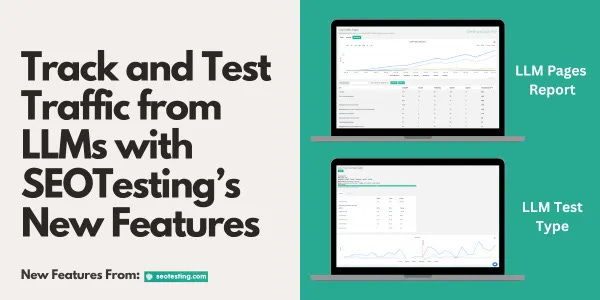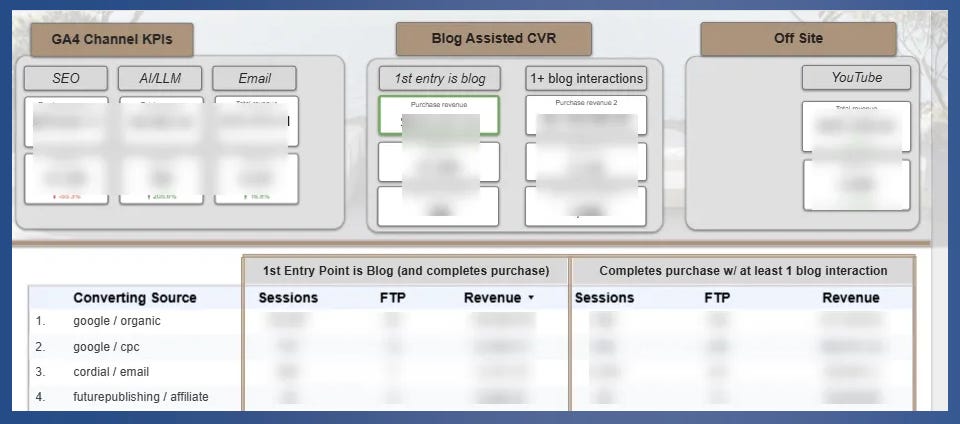The Long Tail Search Has Died. It's All Happening Outside of Google.
SEOs for years relied on "top of funnel" queries to drive brand awareness. Users are evolving and so has how they search for information.
This week’s #SEOForLunch is sponsored by SEOTesting.comIf the LLM era has taught us anything, it’s that user decision-making is evolving fast. People aren’t relying exclusively on Google to answer their questions or kick off their shopping journeys anymore. In fact, studies show that Millennials and Gen Z use Google less than any previous generation.
A special thank you to this week’s #SEOForLunch sponsor: SEOTesting.com
Track and Test Your LLM Traffic!
LLMs are now real discovery channels.
With SEOTesting, you can finally quantify them. The LLM Traffic Pages Report shows you which pages attract visits from ChatGPT, Claude, Perplexity, Gemini, and Copilot, and how that changes over time. Then use our new LLM Test Type to run proper time-based tests on content or technical tweaks and measure uplift in LLM visits per day.
This is all valuable evidence that your stakeholders will trust!
The 4S Lens: Consumer Decision Making Evolved
In February, Google and the Boston Consulting Group published a study highlighting how consumer behavior is reshaping brand discovery. They call it the 4S framework—Streaming, Scrolling, Searching, and Shopping.
Here’s a quick breakdown:
Streaming
Remember waiting for Friday nights to catch your favorite “TGIF” lineup? Now, every day is TGIF. Video, podcasts, and streaming platforms run 24/7, creating passive discovery moments in the background of daily life.
Scrolling
Think of it as the modern-day mall. Only now, the mall is infinite and lives in your pocket. Social feeds, Reddit threads, and Amazon recommendations are where people browse for inspiration…without ever typing a single query.
Searching
This is the “S” SEOs know best. But reliance on search as the first stop is shrinking. Younger generations often start elsewhere and only come to Google later in their decision process.
Shopping
Once upon a time, you had to line up at midnight on Black Friday. Then it moved online. Now? You can buy directly on TikTok, Instagram, YouTube, or (as of last week) inside ChatGPT.
Shopping is everywhere, and that changes how brands reach people.
The Death of the Long Tail
The 4S framework isn’t inherently bad; it’s just different, and different can be scary. It shows that the customer journey is no longer linear. Discovery doesn’t begin and end in search. The long-tail queries SEOs used to count on have been scattered across Streaming, Scrolling, and Shopping experiences.
It makes you wonder if we have been measuring SEO wrong all this time?
As much as it pains SEOs to admit, Google saw this coming. My friend Cindy Krum recently reminded me of Google’s 4S model, and it perfectly explains how users are turning to other sources long before they’re ready to make a purchase.
Where the Long Tail Went
The good news? People haven’t stopped searching.
The bad news? Marketers must work harder to capture the same attention they once received “for free” from Google.
Let’s look at where those discovery moments have moved.
Streaming (LLMs, AI, Podcasts, Video)
YouTube has long been the world’s second-largest search engine for a reason: not everyone learns through text.
Podcasts and videos fill that gap, providing users with visual or multitasking-friendly options.
And then there’s AI. Google’s AI Overviews and other LLMs that serve answers directly within the results, leaving websites behind. Ethics aside, the user gets what they need instantly, without having to read your 1,000-word “how to power on your computer” post.
Scrolling (Social Platforms, Inspiration Browsing)
Today’s long tail lives in social feeds. TikTok, YouTube Shorts, and Instagram Stories drive discovery passively, one scroll at a time.
At the peak of Google search, curiosity led people to Google it. Now, “Googling” is one of the last steps. Inspiration, exploration, and even learning often happen before anyone ever opens a search bar.
Searching (The “Return to Google” Moment)
Good news: SEO isn’t dead. However, Google is no longer the primary destination for the entire journey. It’s simply become just one step in the larger process.
Once users feel informed, they return to Google with higher intent, usually searching branded or head-term queries to further their purchase journey.
In other words, Google has become more bottom-of-funnel than top.
Shopping (Where Conversions Happen)
Discovery may be fragmented, but the purchase funnel still exists.
Top-of-funnel (TOFU), middle-of-funnel (MOFU), and bottom-of-funnel (BOFU)…yes, they’re dumb acronyms, but they still describe how awareness becomes action.
The twist is that streaming and scrolling now dominate the discovery phase. Purchases can (and do) happen entirely off-Google, inside apps or LLMs, without a single “search” click involved.
What It Means for the Funnel
Let’s be clear: discovery and purchase behavior haven’t disappeared—they’ve just spread out.
Google has become a bottom-of-funnel channel.
Optimists say that’s fine since conversions matter most.
Pessimists will continue to shout, “Google is stealing my clicks!”
However, both can agree that with clicks down and purchase intent higher than ever, being found is only the first step.
If SEOs stop at “ranking and traffic,” they’re missing the bigger picture. Today, success depends not only on becoming visible but also on UX and CRO, the parts of the user journey we once ignored because “Google doesn’t rank on that.”
Maybe not…but people do.
What SEOs Need to Do Next
Search isn’t dead (yet), it’s just evolved into one piece of a larger ecosystem.
That means SEOs must double down on areas they can still own:
Branded search visibility
Navigational queries (return policy, phone numbers, support info)
Measuring value beyond GA4’s “organic search” bucket
And yes, SEO just got infinitely more complicated/difficult.
Organic visibility is shrinking, and the long-tail clicks we fought for now live elsewhere. It’s time to build strategies for head terms or redefine success in terms of the broader halo effect that SEO drives.
You’ll need to prove that “raising the tide” lifts all channels, not just organic. If your SEO KPIs look weak, it may not mean performance dropped…it likely means you’re not measuring the whole picture.
🚨 Quick Time Out for Shameless Self-Promotion:
Your next great SEO hire isn’t on LinkedIn. (Neither are the other 999 unqualified applicants.)
What SEOs (and Marketers) Should Do Now
If there’s one silver lining in all this AI/LLM chaos, it’s that it’s finally forcing teams to think (and measure) beyond their own websites.
Raise your hand (mine’s already up) if you’ve had to answer, “Do YouTube videos help SEO?”
The answer has always been, not directly. But maybe we were all asking the wrong question.
The better question: How does YouTube visibility, or Reddit mentions, or TikTok virality influence the path to conversion?
To truly measure the impact of SEO, you have to widen your lens. Think beyond your site and look deeper at YouTube, social media, communities, and forums. These aren’t distractions from SEO; they’re extensions of it.
I’ve started experimenting with new “non-paid media” reporting that blends all these touchpoints. One client, for example, built a huge catalog of educational content over the years. When Google’s changes hit, clicks dropped, but the brand’s broader visibility didn’t. Their audience just shifted platforms.
This new reporting model aims to quantify the halo effect, the unseen value SEO creates across the entire 4S ecosystem. Is it perfect? Absolutely not. I’m still testing and refining it with clients. But what used to be considered a “bonus” is now how we justify budgets and resources.
One thing is clear: the metrics we’ve relied on for years no longer tell the full story. It’s up to us to gather the right data and advocate for the entire value that SEO delivers.
Even if people aren’t clicking your blue links in search, your content is still shaping their decisions…just in places Google doesn’t own.




![[TwG-US]-#2615_V2 [TwG-US]-#2615_V2](https://substackcdn.com/image/fetch/$s_!F5kF!,w_1456,c_limit,f_auto,q_auto:good,fl_progressive:steep/https%3A%2F%2Fsubstack-post-media.s3.amazonaws.com%2Fpublic%2Fimages%2F6618365e-5cb2-4f14-b043-11ae2f8b8142_794x372.png)


I don’t dispute any of that, but anytime I have tried to find answers for anything qualitative on AI overview, Tiktok or anything similar, Google is still superior. But that could be my bias.